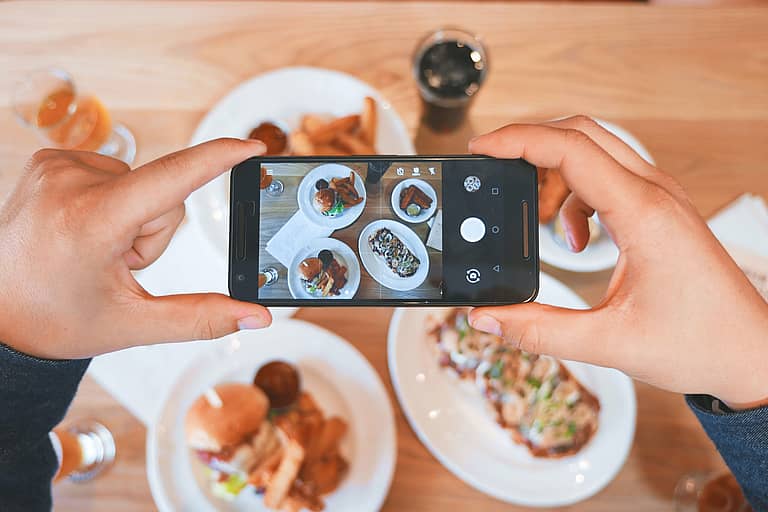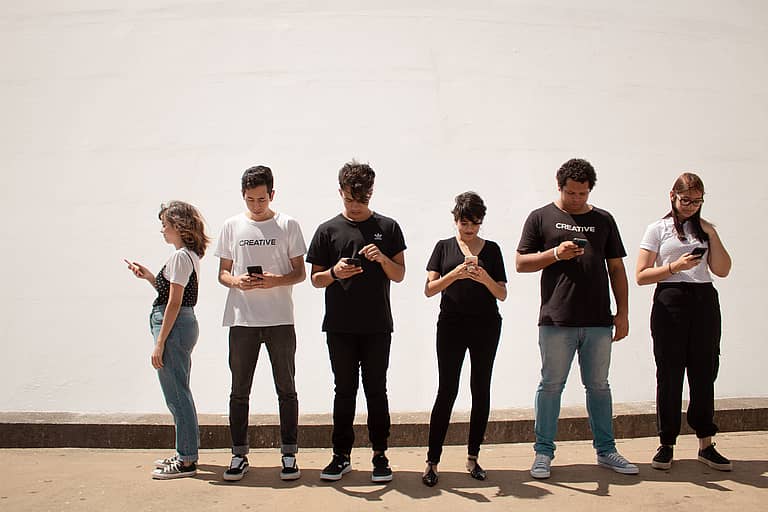Estimated reading time: 9 minutes

The digital world is overflowing with opportunities. Amid the many tactics available, crafting an effective influencer marketing strategy has proven to be pivotal for many brands. But how do you ensure authenticity, quality, and audience engagement? This guide will tell you everything you need to know about influencer marketing and things to consider when crafting an influencer strategy for your business.
What is an Influence Marketer?
An influencer is an individual who has established credibility in a specific niche or industry. Through consistent online presence and engagement, they’ve cultivated a loyal and engaged audience, making them sought-after personalities for brand collaborations. Their influence is predominantly felt on social media platforms, such as Instagram, TikTok, YouTube, and Twitter. But what truly differentiates them from a regular individual with numerous followers?
- Credibility: Over time, influencers earn trust by showcasing knowledge, passion, and authenticity. Their followers value their opinions, making their endorsements powerful.
- Engagement: An influencer isn’t just about vast follower counts but about how they engage with their community. Real influencers have a tangible bond with their audience, fostering dialogues, discussions, and connections.
- Niche Specialization: Most influencers excel in specific domains, be it fashion, technology, travel, or fitness. This specialized content approach ensures that their audience aligns with their expertise.
Types of Influencers:
Navigating the vast realm of influencer marketing begins with understanding the different tiers of influencers. Each category serves distinct roles in the influencer ecosystem:
- Nano Influencers: Nano influencers, often boasting fewer than 5,000 followers, may appear small in numbers but are giants in terms of genuine connection. They tend to have an intimate relationship with their community, making them invaluable for brands seeking grassroots campaigns and genuine organic outreach within niche markets.
- Micro Influencers: Ranging between 5,000 to 50,000 followers, micro influencers strike a harmonious balance between impressive reach and genuine engagement. Their authenticity and tangible connection with their audience make them a favorite among brands seeking meaningful interactions and trust-driven campaigns.
- Macro Influencers: Possessing a follower base from 50,000 to 1 million, macro influencers are often seen as industry voices or thought leaders. Their extensive reach combined with their influential voice makes them the go-to choice for brands aiming for large-scale promotions and campaigns with extensive coverage.
- Mega Influencers: With an enormous following of over a million enthusiasts, mega influencers are the veritable celebrities of the social media domain. Their expansive reach is unparalleled, and collaborations with them guarantee visibility on a grand scale, making them ideal for brands seeking widespread recognition.
What is Influencer Marketing?
Influencer marketing is a modern digital marketing strategy where brands partner with influencers to promote products, services, or campaigns. Instead of targeting a vast audience, brands collaborate with influencers to tap into their established and engaged communities. Here are some defining elements:
- Authentic Promotion: Unlike traditional advertising, influencer marketing often feels more genuine. Influencers integrate brand messaging into their content seamlessly, ensuring it doesn’t disrupt the user experience.
- Targeted Outreach: Brands can reach specific demographic and psychographic segments by partnering with influencers who cater to those exact niches.
- Measurable Outcomes: Leveraging influencers’ digital platforms allows for trackable engagements, traffic, and conversions, providing clear insights into campaign efficacy.
- Trust Building: Consumers are increasingly wary of traditional ads. Influencer marketing offers an authentic voice, as recommendations come from individuals they already trust and follow.
How To Build An Influencer Marketing Strategy
In today’s digital age, influencer marketing has emerged as a powerful tool for brands and businesses to reach their target audience in an authentic and engaging way. Crafting a well-thought-out strategy is essential to harness the full potential of influencer collaborations and ensure a return on investment. Let’s explore:
1. Define Your Objectives:
Clearly charting out your objectives is the cornerstone of any successful campaign. Here are the different objectives you might consider:
- Brand Awareness: Ideal for newer brands, leveraging influencers can introduce your offerings to an expansive audience.
- Engagement: If you’re noticing stagnant or dwindling social metrics, influencers can stimulate them, driving interactions like likes, comments, and shares.
- Lead Generation: Credibility is an influencer’s currency. They can use this to shepherd their followers towards your products or services, spawning potential leads.
- Sales: A direct objective that impacts your bottom line, certain influencer campaigns, especially those armed with promo codes or affiliate links, can be robust sales drivers.
2. Identify Your Target Audience:
Before casting your net, understand the waters. Here’s what you need to grasp about your audience:
- Demographics: Details like age, gender, location, and occupation can provide insights into platform preferences and content consumption habits.
- Psychographics: Going a layer deeper, uncover their values, aspirations, hobbies, and lifestyle. An influencer whose content aligns with these aspects can be tremendously effective.
- Behavioral Traits: It’s essential to discern when your audience is most active online and their content preferences, be it videos, articles, or podcasts.
3. Research Potential Influencers:
Identifying the right influencer is half the battle. Here’s a methodical approach:
- Micro vs. Macro: While macro influencers offer a staggering reach, micro-influencers can be potent for niche markets with superior engagement rates.
- Engagement Rates: Beyond mere follower counts, the quality of interactions, authentic comments, and shares are indicative of a truly engaged and influential creator.
- Past Collaborations: This can give you insights into the influencer’s alignment with certain brands, their style of campaign execution, and the efficacy of their collaborations.
4. Determine Your Budget:
Charting out a budget keeps you grounded and ensures ROI:
- Influencer Compensation: Costs can vary based on factors like platform, reach, and engagement. Understand the nuances of sponsored posts, shoutouts, affiliate collaborations, and extended partnerships.
- Content Creation Costs: If the collaboration involves unique content creation, like videos or high-quality images, factor in costs for production.
- Promotion Costs: Amplifying influencer-generated content with paid promotions can magnify its impact.
5. Craft a Persuasive Pitch:
Your pitch is your first impression:
- Brand Story: Equip influencers with your brand’s ethos, values, and aspirations. This helps them weave your brand seamlessly into their narrative.
- Campaign Vision: Share a blueprint of your vision, be it a series of Instagram stories, a blog post, or a vlog, while being receptive to their creative input.
6. Negotiate Terms and Agreements:
Setting clear terms ensures a smooth collaboration:
- Exclusivity: Discuss if the influencer should refrain from promoting similar brands and for how long.
- Content Rights: Clarify the rights to the content created, like repurposing for ads or other platforms.
- Payment Terms: Finalize compensation structures, like a flat fee, commission, or a blend of both.
7. Collaborate on Content Creation:
Co-creation can lead to magic:
- Brand Guidelines: Share your brand’s aesthetic and tonal preferences, ensuring consistency.
- Feedback Mechanism: Create a loop for feedback, allowing tweaks and iterations before final publication.
8. Monitor and Analyze Performance:
Measuring outcomes ensures accountability:
- Engagement Metrics: Monitor likes, comments, shares, and more. Dive into nuances like the sentiment of comments and the quality of engagement.
- Traffic and Conversion: Use tools and analytics to ascertain the influx of traffic from influencer campaigns and the subsequent conversions.
9. Engage and Interact:
Keep the conversation going:
- Brand Presence: Be present on the influencer’s content, showing support, and engaging with their audience.
- User-Generated Content (UGC): Encourage and leverage UGC, using it as testimonials or for further promotions.
10. Iterate and Optimize:
In the dynamic digital landscape, adaptability is key:
- Feedback Loop: Gather feedback, both from the influencer and the audience. This can be invaluable for future campaigns.
- Pivot When Needed: If metrics show certain strategies aren’t bearing fruit, be nimble and pivot.
Influencer Marketing Strategy Template
A structured approach can significantly simplify the campaign creation process. Here’s an extended template:
- Campaign Name: [E.g., “Summer Fitness Drive”]
- Objectives: [E.g., “Increase website traffic by 50% in Q2”]
- Target Audience:
- Demographics: [Age, Location, Gender]
- Psychographics: [Interests, Values, Habits]
- Preferred Platforms: [E.g., Instagram, TikTok]
- Influencer Details:
- Name: [E.g., “Jane Doe”]
- Platform: [E.g., “Instagram”]
- Follower Count: [E.g., “50,000”]
- Engagement Rate: [E.g., “7%”]
- Budget Details:
- Total Budget: [E.g., “$10,000”]
- Influencer Compensation: [E.g., “$5,000 for 5 posts”]
- Content Creation: [E.g., “$3,000 for professional photoshoot”]
- Promotions: [E.g., “$2,000 for Instagram ads”]
- Timeline: Map out the start and end dates of the campaign, and any key milestones or checkpoints along the way.
- Pitch Details: Outline what your pitch to the influencer will encompass, from the story you’ll tell to the assets you’ll share.
- Content Guidelines: Document your brand’s look, feel, and voice, ensuring influencers resonate with these elements while creating content.
- Engagement Metrics: What are your key performance indicators (KPIs)? List them here and track them regularly.
- Feedback and Iteration: Have a dedicated section to document feedback from all stakeholders and any subsequent iterations to the strategy.
How to Track Influencer Marketing Campaigns:
To truly gauge the effectiveness and ROI of influencer partnerships, brands must implement robust tracking mechanisms. These methods not only measure success but also provide actionable insights for future campaigns:
Unique Promo Codes: By assigning distinct promotional codes to each influencer, brands can effectively track sales and conversions directly attributed to specific influencer campaigns. These codes, while offering a discount or perk to the audience, act as an invaluable metric tool for brands.
UTM Parameters: Digital marketers often resort to UTM tags attached to campaign URLs. This sophisticated tracking system allows brands to pinpoint the precise traffic source, making it a breeze to measure an influencer’s direct impact on web traffic and conversions.
Engagement Metrics: Beyond just likes and comments, engagement metrics dive deep into the sentiment and quality of interactions. Monitoring these nuances, such as the sentiment of comments or depth of shares, paints a detailed picture of the campaign’s resonance with the audience.
Surveys and Polls: In the quest for direct feedback, nothing beats the efficacy of surveys and polls. This method, whether executed on the brand’s platform or through influencers, offers tangible insights into audience preferences, allowing brands to discern which influencers or campaigns resonate the most.
4 Tools for Measuring Your Marketing Campaigns
Influencer Marketing Strategy Mistakes to Avoid:
Collaborating with influencers can be a golden ticket to brand success. However, there are certain pitfalls that brands must navigate to ensure fruitful campaigns:
Mismatched Brand Values: One of the cardinal mistakes brands often make is choosing influencers whose values and ethos don’t resonate with the brand’s own. This mismatch can lead to campaigns that feel forced or inauthentic, ultimately failing to resonate with audiences.
Overlooking Engagement Rates: While it’s easy to get enamored by large follower counts, a seasoned marketer knows that engagement is the true north star. Solely focusing on followers without taking genuine interactions into account can lead to collaborations that lack impact.
Lack of Content Guidelines: Providing influencers with the creative freedom to craft content is essential, but it’s equally crucial to offer clear guidelines. Without this guidance, there’s a risk of content that strays from the brand’s core message or vision.
Ignoring FTC Guidelines: Adherence to advertising regulations isn’t just best practice—it’s mandatory. Both brands and influencers must transparently declare partnerships to maintain credibility and trust with their audience.
Conclusion
An influencer marketing strategy is an indispensable tool in the marketer’s arsenal, understanding its intricacies can offer a competitive edge. Our insightful article on 3 reasons to consider influencer marketing delves deeper into its significance. For a broader spectrum of digital marketing solutions, explore our extensive range of marketing services.



